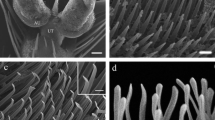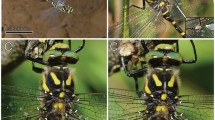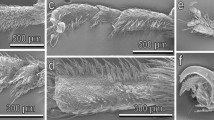Abstract
The ultrastructure of adhesive device or the pulvilli, pad-like structure between the tarsal claws of the legs, is presented in the blowfly (Calliphoridae), housefly and relatives (Muscidae), and flesh fly (Sarcophagidae) through scanning electron microscopy. The blowfly species were Chrysomya chani, Chrysomya nigripes, Chrysomya pinguis, and Chrysomya villeneuvi; while those of the housefly and relatives were Musca domestica and Hydrotaea chalcogaster, respectively. Fresh fly species included Boettcherisca peregrina and Liosarcophaga dux. Numerous tenent setae were observed on the ventral side of the pulvilli. Two features of the tip of the tenent setae were found as a spatula-like (in C. chani, C. pinguis, C. nigripes, M. domestica, H. chalcogaster, B. peregrina, and L. dux) and spoon-like tip (in C. villeneuvi). Transmission electron microscopy of the tenent setae in M. domestica revealed the electron-lucent centrally located, suggesting an adhesive substance. These results provided anatomical information that allow us to not only understand the successful attachment of flies to smooth surfaces but also clarify their role as a mechanical carrier of microorganisms.














Similar content being viewed by others
References
Betz O (1996) Function and evolution of the adhesion-capture apparatus of Stenus species (Coleoptera, Staphylinidae). Zoomorphology 116:15–34
Betz O (2003) Structure of the tarsi in some Stenus species (Coleoptera, Staphylinidae): external morphology, ultrastructure, and tarsal secretion. J Morphol 255:24–43
Betz O, Mumm R (2001) The predatory legs of Philonthus marginatus (Coleoptera, Staphylinidae): functional morphology and tarsal ultrastructure. Arthropod Struct Dev 30:77–97
Betz O, Kölsch G (2004) The role of adhesion in prey capture and predator defence in arthropods. Arthropod Struct Dev 33:3–30
Federle W, Endlein T (2004) Locomotion and adhesion: dynamic control of adhesive surface contact in ants. Arthropod Struct Dev 33:67–75
Federle W, Brainerd EL, McMahon TA, Hölldobler B (2001) Biomechanics of the movable pretarsal adhesive organ in ants and bees. Proc Natl Acad Sci U S A 98:6215–6220
Gaume L, Perret P, Gorb E, Gorb S, Labat JJ, Rowe N (2004) How do plant waxes cause flies to slide? Experimental tests of wax-based trapping mechanisms in three pitfall carnivorous plants. Arthropod Struct Dev 33:103–111
Gorb SN (1998) The design of the fly adhesive pad: distal tenent setae are adapted to the delivery of an adhesive secretion. Proc R Soc Lond B 265:747–752
Gorb SN (2004) Walking on the ceiling: structures, functional principles, and ecological implications. Arthropod Struct Dev 33:1–2
Gorb SN, Gorb EV (2004) Ontogenesis of the attachment ability in the bug Coreus marginatus (Heteroptera, Insecta). J Exp Biol 207:2917–2924
Greenberg B (1971) Flies and disease. Vol. 1. Ecology, classification and biotic associations. Princeton University Press, NJ
Kobayashi M, Sasaki T, Saito N, Tamura K, Suzuki K, Watanabe H, Agui N (1999) Houseflies: not simple mechanical vectors of enterohemorrhagic Escherichia coli 0157:H7. Am J Trop Med Hyg 61:625–629
Levine OS, Levine MM (1991) Houseflies (Musca domestica) as mechanical vectors of shigellosis. Ref Infect Dis 13:688–696
McAlpine DK (1991) Review of the Australian kelp flies (Diptera: Coeloptidae). Syst Entomol 16:29–84
Niederegger S, Gorb S (2003) Tarsal movements in flies during leg attachment and detachment on a smooth substrate. J Insect Physiol 49:611–620
Niederegger S, Gorb S, Jiao Y (2002) Contact behaviour of tenent setae in attachment pads of the blowfly Calliphora vicina (Diptera, Calliphoridae). J Comp Physiol A 187:961–970
Pohl H, Beutel RG (2004) Fine structure of adhesive devices of Strepsiptera (Insecta). Arthropod Struct Dev 33:31–43
Sukontason K, Bunchoo M, Khantawa B, Sukontason K, Piangjai S, Choochote W (2000) Musca domestica as a mechanical carrier of bacteria in Chiang Mai, North Thailand. J Vector Ecol 25:114–117
Sukontason K, Sukontason KL, Piangjai S, Choochote W, Vogtsberger RC (2005) Ultrastructure of the ommatrichia in Megaselia scalaris (Loew) (Diptera: Phoridae). Micron 36:191–194
Sulaiman S, Othman MZ, Aziz AH (2000) Isolations of enteric pathogens from synanthropic flies trapped in downtown Kuala Lumpur. J Vector Ecol 25:90–93
Tan SW, Yap KL, Lee HI (1997) Mechanical transport of rotavirus by the legs and wings of Musca domestica (Diptera: Muscidae). J Med Entomol 34:527–531
Acknowledgement
This work received support from the Faculty of Medicine Endowment Fund for Medical Research.
Author information
Authors and Affiliations
Corresponding author
Rights and permissions
About this article
Cite this article
Sukontason, K.L., Bunchu, N., Methanitikorn, R. et al. Ultrastructure of adhesive device in fly in families calliphoridae, muscidae and sarcophagidae, and their implication as mechanical carriers of pathogens. Parasitol Res 98, 477–481 (2006). https://doi.org/10.1007/s00436-005-0100-0
Received:
Accepted:
Published:
Issue Date:
DOI: https://doi.org/10.1007/s00436-005-0100-0




